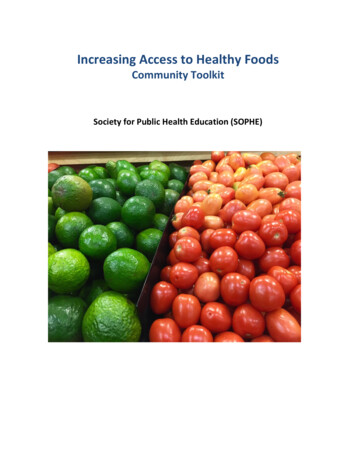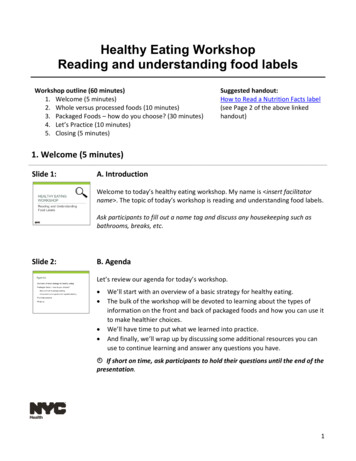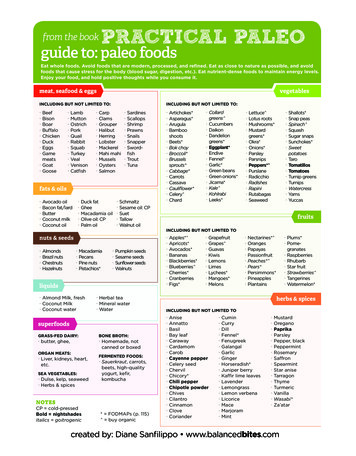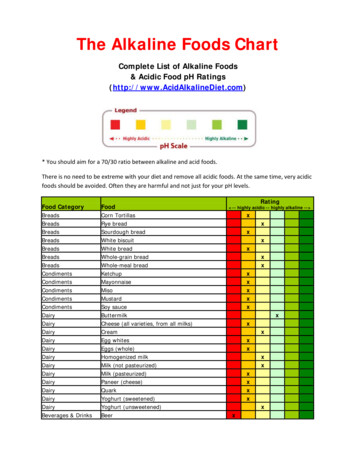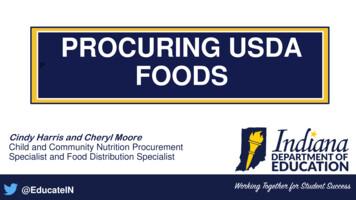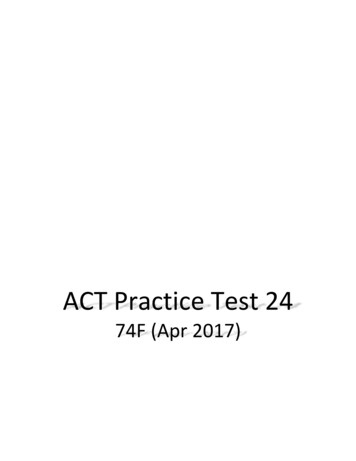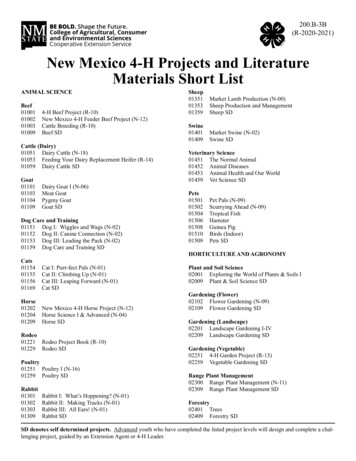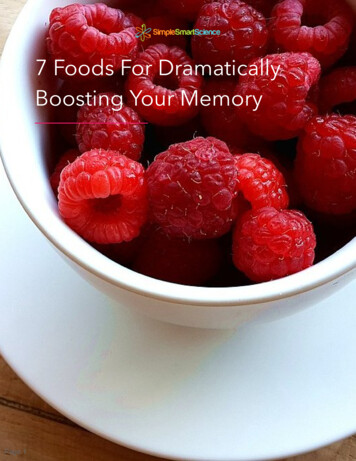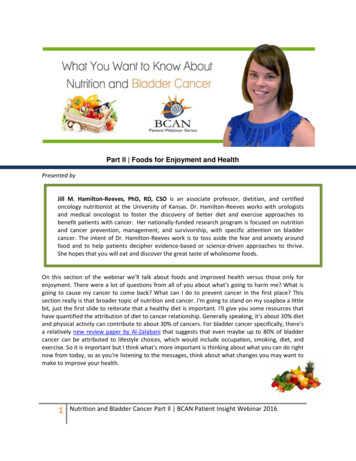
Transcription
Part ll Foods for Enjoyment and HealthPresented byJill M. Hamilton-Reeves, PhD, RD, CSO is an associate professor, dietitian, and certifiedoncology nutritionist at the University of Kansas. Dr. Hamilton-Reeves works with urologistsand medical oncologist to foster the discovery of better diet and exercise approaches tobenefit patients with cancer. Her nationally-funded research program is focused on nutritionand cancer prevention, management, and survivorship, with specific attention on bladdercancer. The intent of Dr. Hamilton-Reeves work is to toss aside the fear and anxiety aroundfood and to help patients decipher evidence-based or science-driven approaches to thrive.She hopes that you will eat and discover the great taste of wholesome foods.On this section of the webinar we'll talk about foods and improved health versus those only forenjoyment. There were a lot of questions from all of you about what's going to harm me? What isgoing to cause my cancer to come back? What can I do to prevent cancer in the first place? Thissection really is that broader topic of nutrition and cancer. I'm going to stand on my soapbox a littlebit, just the first slide to reiterate that a healthy diet is important. I'll give you some resources thathave quantified the attribution of diet to cancer relationship. Generally speaking, it's about 30% dietand physical activity can contribute to about 30% of cancers. For bladder cancer specifically, there'sa relatively new review paper by Al-Zalabani that suggests that even maybe up to 80% of bladdercancer can be attributed to lifestyle choices, which would include occupation, smoking, diet, andexercise. So it is important but I think what's more important is thinking about what you can do rightnow from today, so as you're listening to the messages, think about what changes you may want tomake to improve your health.1Nutrition and Bladder Cancer Part ll BCAN Patient Insight Webinar 2016
I really don't think that fearand anxiety are a part of this,so let that go. Fear andanxiety around food shouldjust go away because eatingcan be enjoyable and easywithout harming your healthand today I hope to provideyou some tools to help you godown that path with learninghowtokeepyourselfnourished and enjoy the foodthat you're eating.One of the critical resourcesthat I'd like to point you to isthe American Institute ForCancer Research. They're anauthority on diet, physicalactivity, and cancer.This infographic that I have onhere is from them and itessentially just highlights the mainmessages for diet and cancer.Maintain a healthy weight, try tomove more, eat well, try to eat aplant-based diet, reduce red meat,avoid processed meat, cut downon alcohol, eat less salt.After treatment, cancer survivorsshould follow the same cancerprevention guidelines and then itsays for cancer prevention, don'tuse supplements. We will touch onthat topic again in the last sectionof today's webinar. A healthy dietmeans different things to differentpeople so just so we can all get onone page. A healthy diet from myperspective includes a variety ofvegetables, fruits, whole grains,nuts, seeds, legumes or beans,poultry, and fish.2Nutrition and Bladder Cancer Part ll BCAN Patient Insight Webinar 2016
Some foods and drinks may be protective, specifically for bladder cancer. This is arelatively newer field of study but some studies show that greater consumption ofvegetables and fruit decrease the risk of bladder cancer and some studies showthat greater consumption of tea decreases the risk of bladder cancer.First, we'll talk about tea and bladdercancer. Each cup of tea per day has beenassociated with 6% decrease risk of bladdercancer, and that's from the Chen study.Animal studies have seen that polyphenolcompounds inhibit bladder tumor growth.Coffee and tea have been studies inreducing the risk of other cancers. Greenteas contains epigallocatechin-3-gallatewhich has shown anti-cancer properties. Inregards to bladder cancer prevention, reallythe best type of tea has not yet beendetermined. The black tea versus oolong orgreen tea seem to be about equivocal inmost studies.This next slide is aboutvegetables, fruits, and bladdercancer. Total vegetable and fruitconsumptionhavebeenassociated with a 10% decreasein bladder cancer risk per servingand then also citrus fruits such asoranges, lemons, limes, andgrape fruit, might be protectivethrough their antioxidant action.Cruciferous vegetables, whichyou would know better asbroccoli, cauliflower, cabbage,kale, brussel sprouts, andasparagus, contain a compoundcalled sulforaphane and there'ssome studies suggesting that thatmay help inhibit bladder cancer growth.3Nutrition and Bladder Cancer Part ll BCAN Patient Insight Webinar 2016
How many vegetables and fruits do I need?The American Institute of Cancer Research recommends 5 servings of non-starchy vegetables andfruits every day. A serving size is one of those things that dietitians, I think, get a little bit finicky andcaught up on. We're like the accountants of the health system. A serving size is somewhere betweena half to a cup of fruit, 1-2 cups of raw vegetables, or a half a cup of cooked vegetables.It's important to get a variety of different colors of vegetables including red, green, white, purple,yellow, and orange. Those colors are associated with different nutrients in your foods that have theproperties that help with cancer prevention so that's why we aim to get a lot of different colors offruits and vegetables.4Nutrition and Bladder Cancer Part ll BCAN Patient Insight Webinar 2016
There were some questions about juicing and there are some benefits of juicing. It can increase theamount of nutrients that you can consume each day, and still get it from food. It can really benefitthose who are having difficulty with chewing or digesting food. I do have some tips though. Juicingitself, when you use a juicer, it takes out the fiber and fiber is an important nutrient for gut health.For this reason, if you're not having feeding difficulties, you should really aim for your 5 servings ofvegetables and fruit before you juice and then add the juicing vegetables and fruits on after that. Itwould be a good idea to include more vegetables than fruit because they have fewer calories, lesssugar, as far as keeping weight stable.Then drink what you normally would eat, aim for a variety. Somepeople suggest including some protein with your juice so that if youare a person that has problems keeping your blood sugar at a normallevel, the protein will kind of blunt the sugar response and makingyou hyperglycemic or have high blood sugars. Just a note of caution,not all commercial juices, if you buy them off the shelf, have thenutrients that you're really looking for so you need to become anavid label reader and look at the added sugar content, which is nowcalled out on the food label.One other thing about juicing is there is also the option of blendingfoods, so you would get the fiber if you had a high power blender likea Vitamix and you threw all the fruits and vegetables in there and then blend that up. That's a reallygreat option for those of you that might be going through therapy and having issues with mouthsores or other feeding issues.5Nutrition and Bladder Cancer Part ll BCAN Patient Insight Webinar 2016
Other components of a healthy diet.I mention legumes or beans, so it's an example of lentils, black beans, split peas, garbanzo beans,soy beans, peanuts, navy beans, also whole grains like oatmeal, quinoa, barley, 100% whole grainproducts are really a beneficial part of the diet. Nuts, seeds, and health fats, like walnut, chia seeds,flax seed, pecans, almonds, cashews, olive oil, avocados, dairy such as yogurt, milk, cheese, andkefir, kefir is fermented milk products, so it's kind of like liquid yogurt, and then proteins such asfish, eggs, and poultry.6Nutrition and Bladder Cancer Part ll BCAN Patient Insight Webinar 2016
There are some foods that have data behind them suggesting a link with cancer so red meat hasbeen associated with an increased risk of certain cancers but the data are inconsistent for bladdercancer. Still, the recommendation for cancer prevention includes limiting red meat to 18 ounces perweek. I live in Kansas City and so that's a tough one to sell to our patients, but it is what it is.The other one is actually more relevant to bladder cancer. There are data showing that processedmeats, so any kind of meat that has been preserved by smoking, curing, salting, or the addition ofchemicals such as nitrate, should be avoided. Examples of these foods include bacon, sausage,hotdogs, and luncheon meats. I often get the question if the naturally preserved hotdogs and baconand things like that are any better or if they come from turkey instead of red meat, is that anybetter?Sadly, they still use nitrates to preserve those foods. It's usually just a nitrate that is derived fromcelery but the body doesn't distinguish between that. We don't really have any solid data saying thatthose are either better or worse for you and so the recommendation is simply just to limit theamount of processed meats that you consume.7Nutrition and Bladder Cancer Part ll BCAN Patient Insight Webinar 2016
Sugary drinks. We talked about that in the myth part (see Nutrition and Bladder Cancer Part l) of thewebinar. They do not cause cancer but they really do not add much benefit to our health so we talkabout limiting those.Energy-dense foods such as processed foods that are high in added sugar or low in fiber, like chips,fries, candy, pastries, those could contribute to unwanted weight gain and take the place ofnutrient-rich foods in our diet.Alcohol, if consumed at all, should be consumed in moderation, two drinks or less for men per day,or one drink per day or less for women, and then food processed with salt should be limited. Again,those are more general diet and cancer kind of relationships.8Nutrition and Bladder Cancer Part ll BCAN Patient Insight Webinar 2016
I just want to take a note to talk about bladder cancer and blood sugar control. There's some workfrom Ahn and colleagues that was just published this year, showing that patients that had nonmuscle invasive bladder cancer and uncontrolled diabetes had a higher rate of progression. I noticedquite a few of you on the call who are undergoing BCG treatment and TURBT and so this might berelevant to you if you have diabetes or you're at risk. Maybe you're blood sugars run a little bit highand you're pre-diabetic. Keeping a tight blood sugar control before and after surgery has beenassociated with longer progression free survival. The take home message here is that patients withdiabetes should aim to manage their blood sugars with exercise and a carbohydrate-controlled diet.We actually have a small feasibility study here at the University of Kansas where we are trying a lowcarbohydrate diet in patients on BCG so hopefully some of those participants are on the call, sothanks for joining us if you are on the call.People that asked, tell me the goodand the bad, and now just tell mewhat to eat. Love how candid all ofyour questions were. It was justreally good to keep me groundedon what's important to all of you.The best diet for bladder cancerprevention is a balanced one sohopefully that message has comethrough.The American Institute for CancerResearch has several guidelines onhow you would build this kind ofdiet and they call their program the9Nutrition and Bladder Cancer Part ll BCAN Patient Insight Webinar 2016
New American Plate and the picture here shows youwhat the new American Plate could look like. Somethings to know on this plate is that there's two servingsof vegetables here and there's a smaller amount ofanimal protein and then a kind of carb-controlledamount of rice on the plate. The recommendation is tofill two-thirds or more of your plate with vegetables,fruits, whole grains, and beans and limit the animalprotein to a third of the plate to fish and lean poultrymore often. The New American Plate does have severalrecipes. People were asking for some recipes so whenyou go to your handout again it's the AICR handout andyou can find those resources there.Some take home messages for this section is to make themajority of your diet vegetables, fruits, whole grains,legumes, nuts, seeds, fish, and lean poultry, and limit processed meats, red meats, refined, starchyfoods, and sugars to special occasions. Again, I'm not demonizing any food. I really want thatmessage to come through nice and clear, but just to recognize that some foods are really not just forenjoyment and others have more of a capacity for nourishment.10Nutrition and Bladder Cancer Part ll BCAN Patient Insight Webinar 2016
11Nutrition and Bladder Cancer Part ll BCAN Patient Insight Webinar 2016
6 Nutrition and Bladder Cancer Part ll BCAN Patient Insight Webinar 2016 Other components of a healthy diet. I mention legumes or beans, so it's an example of lentils, black beans, split peas, garbanzo beans, soy beans, peanuts, navy beans, also whole grains like oatmeal, quinoa, barley, 100% whole grain



